Global Business Report: Analysis of Globalization and Business
VerifiedAdded on 2022/12/23
|7
|1738
|65
Report
AI Summary
This report provides a comprehensive analysis of globalization and its impact on global business, addressing key aspects such as the definition of globalization, its main drivers including technological advancements, international trade, and investment. It examines the changing nature of the global economy, focusing on the increasing interconnectedness and the rise of emerging nations. The report further explores the arguments for and against globalization, including its effects on poverty, economic growth, job markets, and national independence. Finally, it evaluates the opportunities and challenges globalization presents for management practices, considering factors like specialization, cultural diversity, technological advancements, and increased competition. The report uses examples like Nutella and Singapore's digital workforce readiness to illustrate key concepts, and it also includes references to support the analysis.

Running Head: MANAGEMENT 0
GLOBAL BUSINESS
GLOBAL BUSINESS
Paraphrase This Document
Need a fresh take? Get an instant paraphrase of this document with our AI Paraphraser
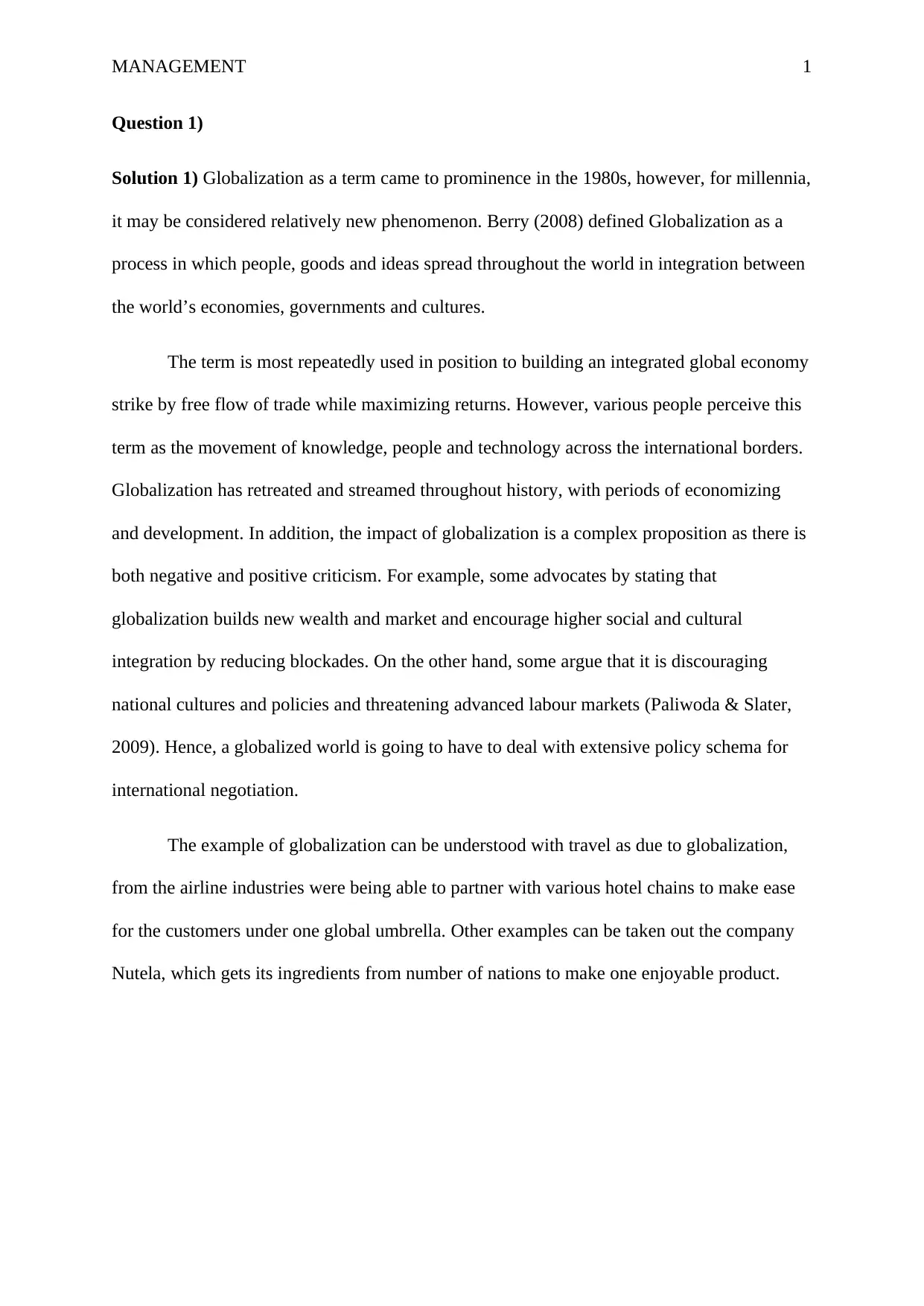
MANAGEMENT 1
Question 1)
Solution 1) Globalization as a term came to prominence in the 1980s, however, for millennia,
it may be considered relatively new phenomenon. Berry (2008) defined Globalization as a
process in which people, goods and ideas spread throughout the world in integration between
the world’s economies, governments and cultures.
The term is most repeatedly used in position to building an integrated global economy
strike by free flow of trade while maximizing returns. However, various people perceive this
term as the movement of knowledge, people and technology across the international borders.
Globalization has retreated and streamed throughout history, with periods of economizing
and development. In addition, the impact of globalization is a complex proposition as there is
both negative and positive criticism. For example, some advocates by stating that
globalization builds new wealth and market and encourage higher social and cultural
integration by reducing blockades. On the other hand, some argue that it is discouraging
national cultures and policies and threatening advanced labour markets (Paliwoda & Slater,
2009). Hence, a globalized world is going to have to deal with extensive policy schema for
international negotiation.
The example of globalization can be understood with travel as due to globalization,
from the airline industries were being able to partner with various hotel chains to make ease
for the customers under one global umbrella. Other examples can be taken out the company
Nutela, which gets its ingredients from number of nations to make one enjoyable product.
Question 1)
Solution 1) Globalization as a term came to prominence in the 1980s, however, for millennia,
it may be considered relatively new phenomenon. Berry (2008) defined Globalization as a
process in which people, goods and ideas spread throughout the world in integration between
the world’s economies, governments and cultures.
The term is most repeatedly used in position to building an integrated global economy
strike by free flow of trade while maximizing returns. However, various people perceive this
term as the movement of knowledge, people and technology across the international borders.
Globalization has retreated and streamed throughout history, with periods of economizing
and development. In addition, the impact of globalization is a complex proposition as there is
both negative and positive criticism. For example, some advocates by stating that
globalization builds new wealth and market and encourage higher social and cultural
integration by reducing blockades. On the other hand, some argue that it is discouraging
national cultures and policies and threatening advanced labour markets (Paliwoda & Slater,
2009). Hence, a globalized world is going to have to deal with extensive policy schema for
international negotiation.
The example of globalization can be understood with travel as due to globalization,
from the airline industries were being able to partner with various hotel chains to make ease
for the customers under one global umbrella. Other examples can be taken out the company
Nutela, which gets its ingredients from number of nations to make one enjoyable product.
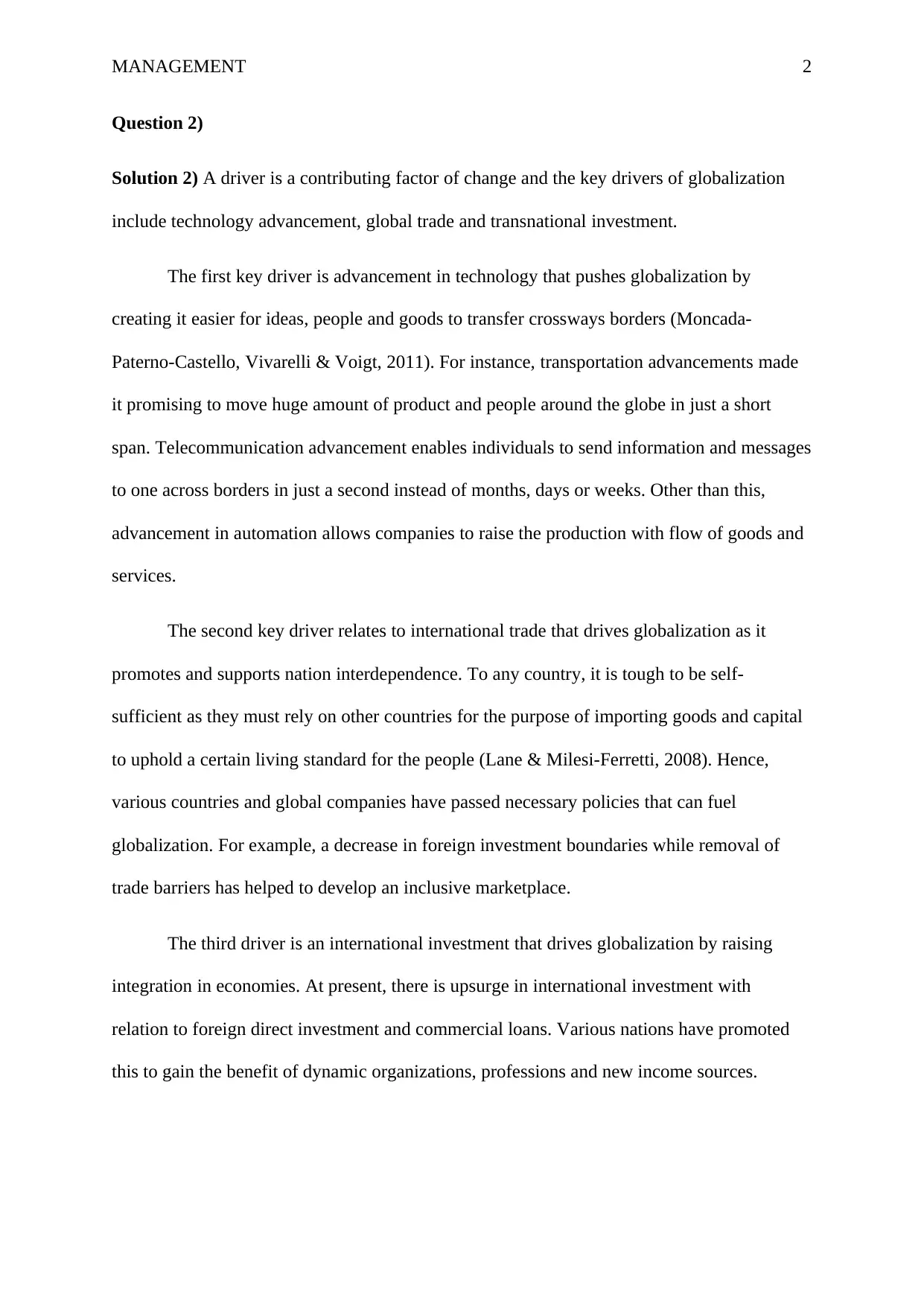
MANAGEMENT 2
Question 2)
Solution 2) A driver is a contributing factor of change and the key drivers of globalization
include technology advancement, global trade and transnational investment.
The first key driver is advancement in technology that pushes globalization by
creating it easier for ideas, people and goods to transfer crossways borders (Moncada-
Paterno-Castello, Vivarelli & Voigt, 2011). For instance, transportation advancements made
it promising to move huge amount of product and people around the globe in just a short
span. Telecommunication advancement enables individuals to send information and messages
to one across borders in just a second instead of months, days or weeks. Other than this,
advancement in automation allows companies to raise the production with flow of goods and
services.
The second key driver relates to international trade that drives globalization as it
promotes and supports nation interdependence. To any country, it is tough to be self-
sufficient as they must rely on other countries for the purpose of importing goods and capital
to uphold a certain living standard for the people (Lane & Milesi-Ferretti, 2008). Hence,
various countries and global companies have passed necessary policies that can fuel
globalization. For example, a decrease in foreign investment boundaries while removal of
trade barriers has helped to develop an inclusive marketplace.
The third driver is an international investment that drives globalization by raising
integration in economies. At present, there is upsurge in international investment with
relation to foreign direct investment and commercial loans. Various nations have promoted
this to gain the benefit of dynamic organizations, professions and new income sources.
Question 2)
Solution 2) A driver is a contributing factor of change and the key drivers of globalization
include technology advancement, global trade and transnational investment.
The first key driver is advancement in technology that pushes globalization by
creating it easier for ideas, people and goods to transfer crossways borders (Moncada-
Paterno-Castello, Vivarelli & Voigt, 2011). For instance, transportation advancements made
it promising to move huge amount of product and people around the globe in just a short
span. Telecommunication advancement enables individuals to send information and messages
to one across borders in just a second instead of months, days or weeks. Other than this,
advancement in automation allows companies to raise the production with flow of goods and
services.
The second key driver relates to international trade that drives globalization as it
promotes and supports nation interdependence. To any country, it is tough to be self-
sufficient as they must rely on other countries for the purpose of importing goods and capital
to uphold a certain living standard for the people (Lane & Milesi-Ferretti, 2008). Hence,
various countries and global companies have passed necessary policies that can fuel
globalization. For example, a decrease in foreign investment boundaries while removal of
trade barriers has helped to develop an inclusive marketplace.
The third driver is an international investment that drives globalization by raising
integration in economies. At present, there is upsurge in international investment with
relation to foreign direct investment and commercial loans. Various nations have promoted
this to gain the benefit of dynamic organizations, professions and new income sources.
⊘ This is a preview!⊘
Do you want full access?
Subscribe today to unlock all pages.

Trusted by 1+ million students worldwide
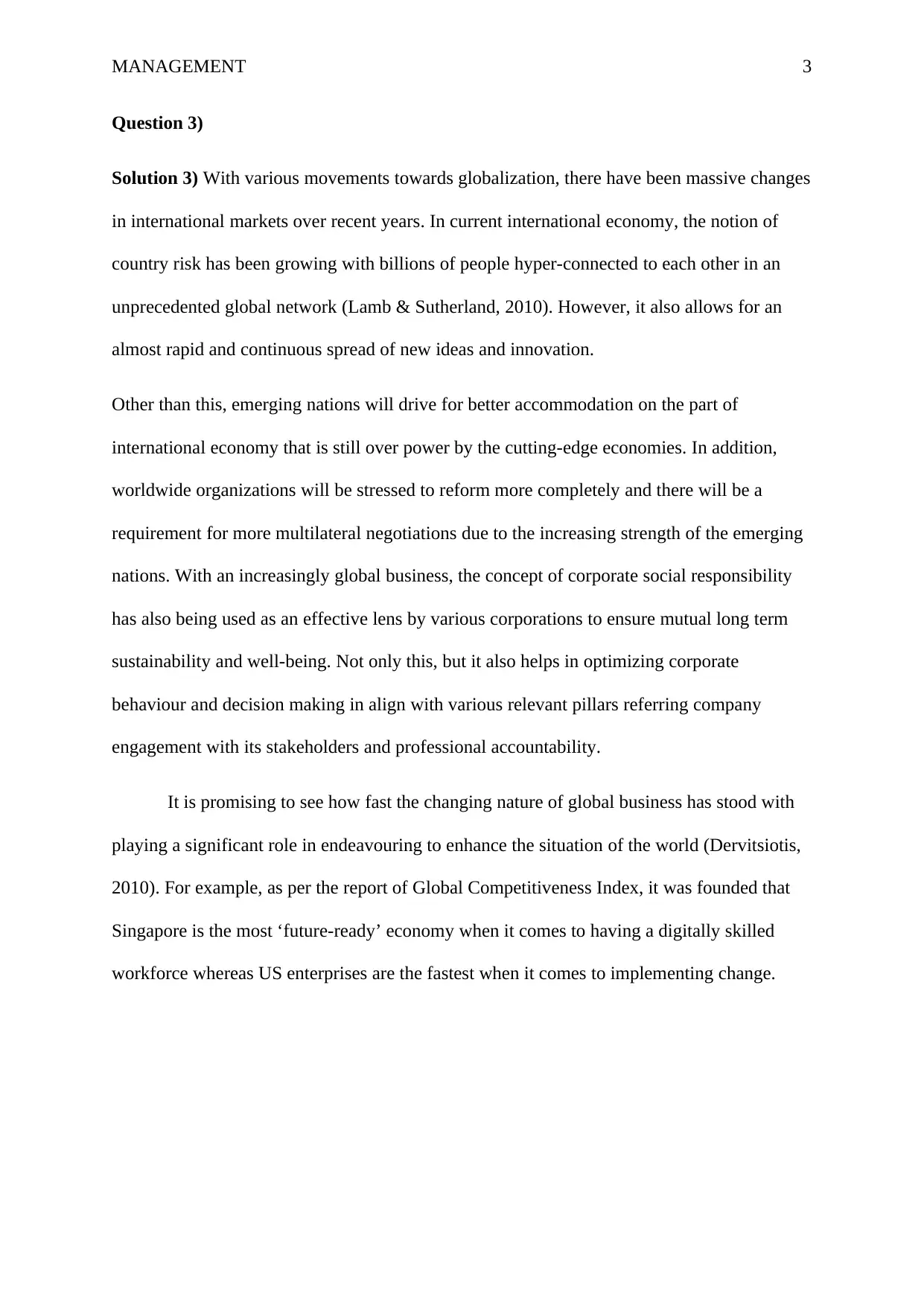
MANAGEMENT 3
Question 3)
Solution 3) With various movements towards globalization, there have been massive changes
in international markets over recent years. In current international economy, the notion of
country risk has been growing with billions of people hyper-connected to each other in an
unprecedented global network (Lamb & Sutherland, 2010). However, it also allows for an
almost rapid and continuous spread of new ideas and innovation.
Other than this, emerging nations will drive for better accommodation on the part of
international economy that is still over power by the cutting-edge economies. In addition,
worldwide organizations will be stressed to reform more completely and there will be a
requirement for more multilateral negotiations due to the increasing strength of the emerging
nations. With an increasingly global business, the concept of corporate social responsibility
has also being used as an effective lens by various corporations to ensure mutual long term
sustainability and well-being. Not only this, but it also helps in optimizing corporate
behaviour and decision making in align with various relevant pillars referring company
engagement with its stakeholders and professional accountability.
It is promising to see how fast the changing nature of global business has stood with
playing a significant role in endeavouring to enhance the situation of the world (Dervitsiotis,
2010). For example, as per the report of Global Competitiveness Index, it was founded that
Singapore is the most ‘future-ready’ economy when it comes to having a digitally skilled
workforce whereas US enterprises are the fastest when it comes to implementing change.
Question 3)
Solution 3) With various movements towards globalization, there have been massive changes
in international markets over recent years. In current international economy, the notion of
country risk has been growing with billions of people hyper-connected to each other in an
unprecedented global network (Lamb & Sutherland, 2010). However, it also allows for an
almost rapid and continuous spread of new ideas and innovation.
Other than this, emerging nations will drive for better accommodation on the part of
international economy that is still over power by the cutting-edge economies. In addition,
worldwide organizations will be stressed to reform more completely and there will be a
requirement for more multilateral negotiations due to the increasing strength of the emerging
nations. With an increasingly global business, the concept of corporate social responsibility
has also being used as an effective lens by various corporations to ensure mutual long term
sustainability and well-being. Not only this, but it also helps in optimizing corporate
behaviour and decision making in align with various relevant pillars referring company
engagement with its stakeholders and professional accountability.
It is promising to see how fast the changing nature of global business has stood with
playing a significant role in endeavouring to enhance the situation of the world (Dervitsiotis,
2010). For example, as per the report of Global Competitiveness Index, it was founded that
Singapore is the most ‘future-ready’ economy when it comes to having a digitally skilled
workforce whereas US enterprises are the fastest when it comes to implementing change.
Paraphrase This Document
Need a fresh take? Get an instant paraphrase of this document with our AI Paraphraser
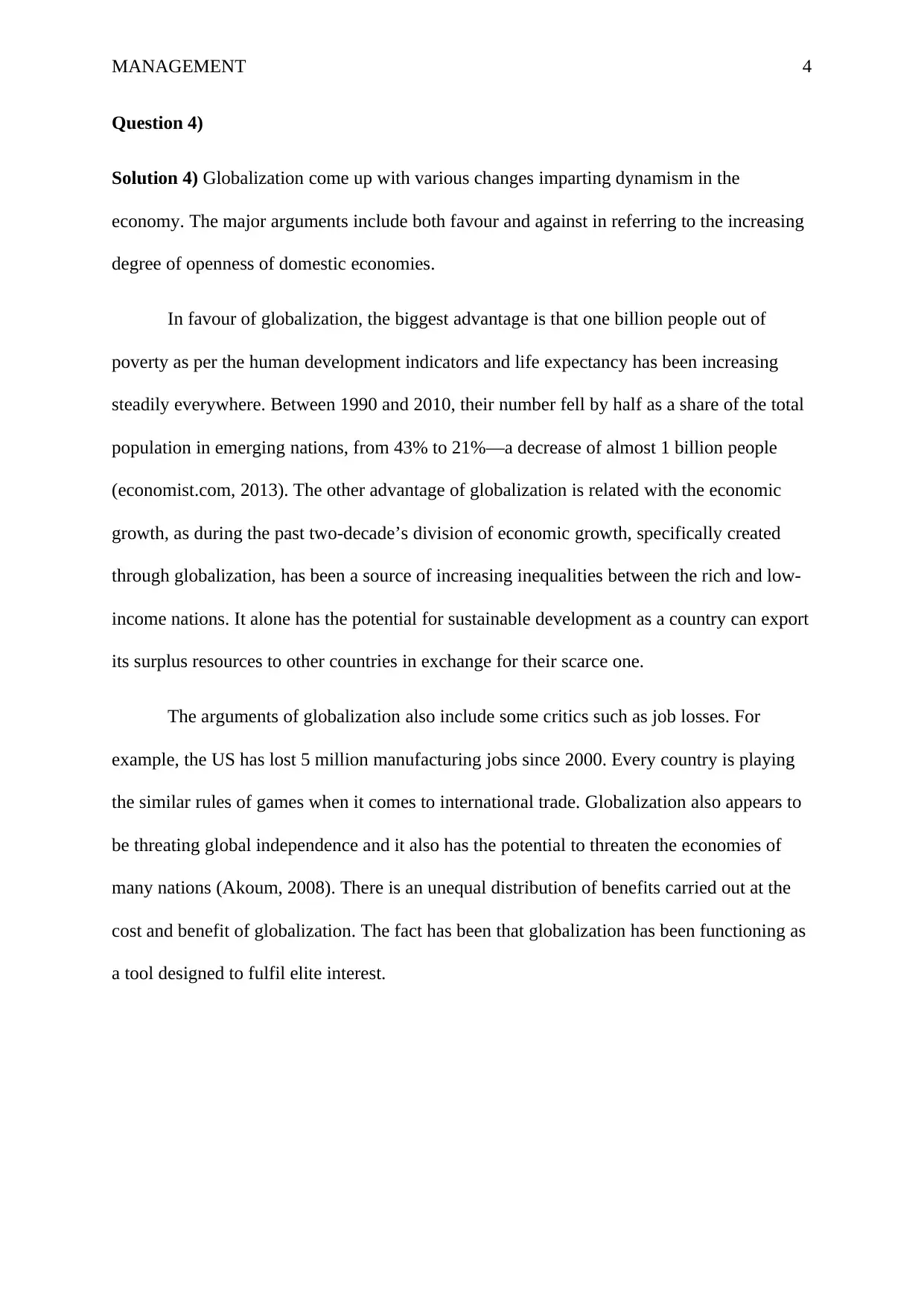
MANAGEMENT 4
Question 4)
Solution 4) Globalization come up with various changes imparting dynamism in the
economy. The major arguments include both favour and against in referring to the increasing
degree of openness of domestic economies.
In favour of globalization, the biggest advantage is that one billion people out of
poverty as per the human development indicators and life expectancy has been increasing
steadily everywhere. Between 1990 and 2010, their number fell by half as a share of the total
population in emerging nations, from 43% to 21%—a decrease of almost 1 billion people
(economist.com, 2013). The other advantage of globalization is related with the economic
growth, as during the past two-decade’s division of economic growth, specifically created
through globalization, has been a source of increasing inequalities between the rich and low-
income nations. It alone has the potential for sustainable development as a country can export
its surplus resources to other countries in exchange for their scarce one.
The arguments of globalization also include some critics such as job losses. For
example, the US has lost 5 million manufacturing jobs since 2000. Every country is playing
the similar rules of games when it comes to international trade. Globalization also appears to
be threating global independence and it also has the potential to threaten the economies of
many nations (Akoum, 2008). There is an unequal distribution of benefits carried out at the
cost and benefit of globalization. The fact has been that globalization has been functioning as
a tool designed to fulfil elite interest.
Question 4)
Solution 4) Globalization come up with various changes imparting dynamism in the
economy. The major arguments include both favour and against in referring to the increasing
degree of openness of domestic economies.
In favour of globalization, the biggest advantage is that one billion people out of
poverty as per the human development indicators and life expectancy has been increasing
steadily everywhere. Between 1990 and 2010, their number fell by half as a share of the total
population in emerging nations, from 43% to 21%—a decrease of almost 1 billion people
(economist.com, 2013). The other advantage of globalization is related with the economic
growth, as during the past two-decade’s division of economic growth, specifically created
through globalization, has been a source of increasing inequalities between the rich and low-
income nations. It alone has the potential for sustainable development as a country can export
its surplus resources to other countries in exchange for their scarce one.
The arguments of globalization also include some critics such as job losses. For
example, the US has lost 5 million manufacturing jobs since 2000. Every country is playing
the similar rules of games when it comes to international trade. Globalization also appears to
be threating global independence and it also has the potential to threaten the economies of
many nations (Akoum, 2008). There is an unequal distribution of benefits carried out at the
cost and benefit of globalization. The fact has been that globalization has been functioning as
a tool designed to fulfil elite interest.

MANAGEMENT 5
Question 5)
Solution 5) Globalization creates opportunities and challenges for both countries and
organisation. In extent with opportunities, it allows specialization allowing various parts of
the product. It helps in dealing with employees comes from different backgrounds and
cultures and thus create synergies through collaboration, allowing specialists to emphasis on
their corporate strengths. Globalization also strengthens the management practices with
increasing the intensity of R&D, innovation and capital in their output (Farndale, Scullion &
Sparrow, 2010). It also gives control to the management with spread of new technology
helping the products to be more efficient and cost effective. The management also now able
to take account of various issues such as gender wage discrimination as it is offering new
opportunities to the women. In addition, globalization has also enhanced the quality of
management in organizations and employees working conditions.
On the other hand, it also brings out various challenges such as increase in complexity
of the practice of management due to various factors of the macro environment. For example,
globalization increases the technological boundaries and thus management is required to gain
necessary skills to cope up with this new technology. Hence, there are deep flaws in the view
of globalization. Other than this, recruiting talented pool is now also a major concern for the
management due to rise in competition (Dominelli, 2010). In last, it also increases cost of
doing business in relation with infrastructure, recruitment, communication (translator),
transport and so on.
Question 5)
Solution 5) Globalization creates opportunities and challenges for both countries and
organisation. In extent with opportunities, it allows specialization allowing various parts of
the product. It helps in dealing with employees comes from different backgrounds and
cultures and thus create synergies through collaboration, allowing specialists to emphasis on
their corporate strengths. Globalization also strengthens the management practices with
increasing the intensity of R&D, innovation and capital in their output (Farndale, Scullion &
Sparrow, 2010). It also gives control to the management with spread of new technology
helping the products to be more efficient and cost effective. The management also now able
to take account of various issues such as gender wage discrimination as it is offering new
opportunities to the women. In addition, globalization has also enhanced the quality of
management in organizations and employees working conditions.
On the other hand, it also brings out various challenges such as increase in complexity
of the practice of management due to various factors of the macro environment. For example,
globalization increases the technological boundaries and thus management is required to gain
necessary skills to cope up with this new technology. Hence, there are deep flaws in the view
of globalization. Other than this, recruiting talented pool is now also a major concern for the
management due to rise in competition (Dominelli, 2010). In last, it also increases cost of
doing business in relation with infrastructure, recruitment, communication (translator),
transport and so on.
⊘ This is a preview!⊘
Do you want full access?
Subscribe today to unlock all pages.

Trusted by 1+ million students worldwide
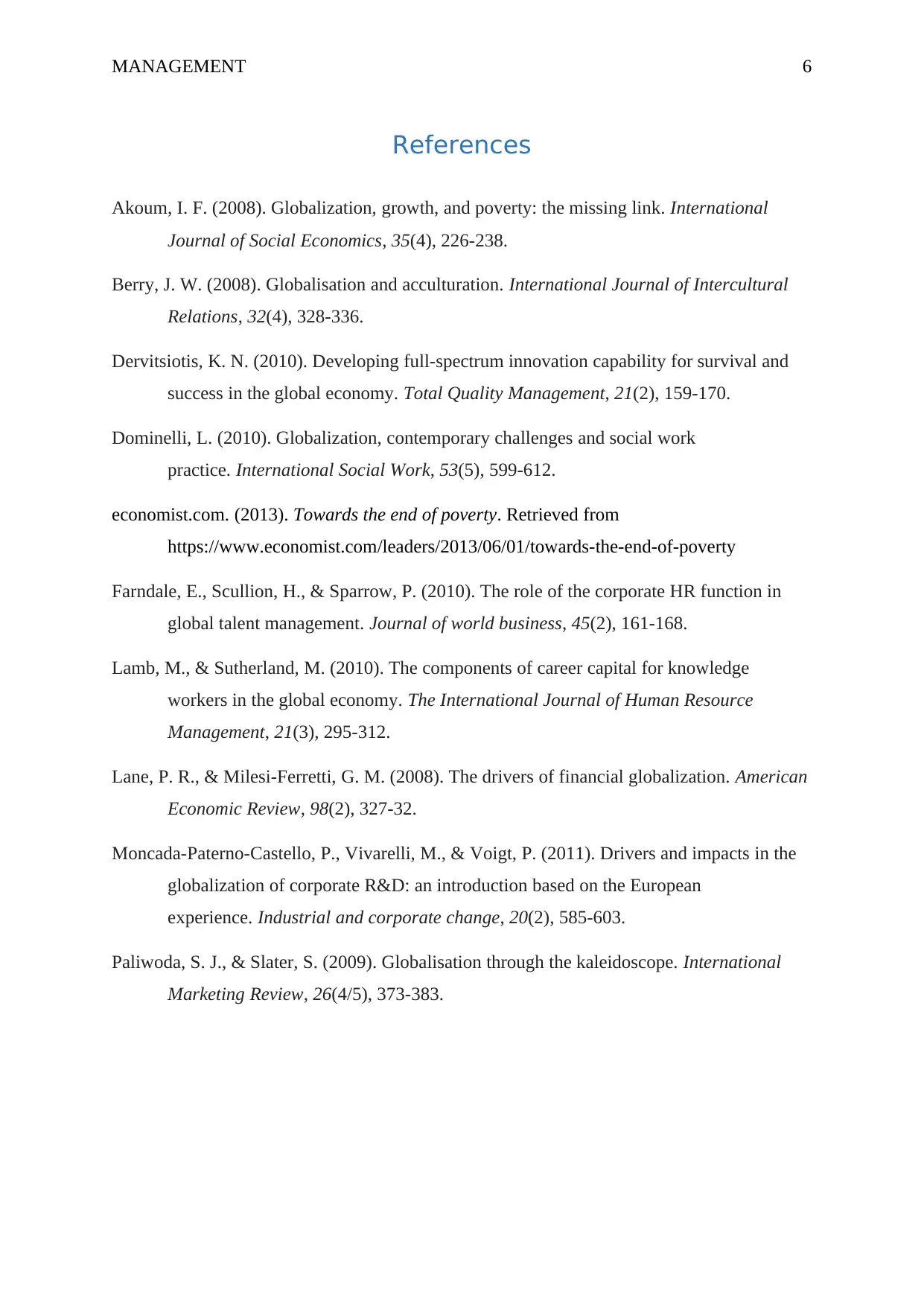
MANAGEMENT 6
References
Akoum, I. F. (2008). Globalization, growth, and poverty: the missing link. International
Journal of Social Economics, 35(4), 226-238.
Berry, J. W. (2008). Globalisation and acculturation. International Journal of Intercultural
Relations, 32(4), 328-336.
Dervitsiotis, K. N. (2010). Developing full-spectrum innovation capability for survival and
success in the global economy. Total Quality Management, 21(2), 159-170.
Dominelli, L. (2010). Globalization, contemporary challenges and social work
practice. International Social Work, 53(5), 599-612.
economist.com. (2013). Towards the end of poverty. Retrieved from
https://www.economist.com/leaders/2013/06/01/towards-the-end-of-poverty
Farndale, E., Scullion, H., & Sparrow, P. (2010). The role of the corporate HR function in
global talent management. Journal of world business, 45(2), 161-168.
Lamb, M., & Sutherland, M. (2010). The components of career capital for knowledge
workers in the global economy. The International Journal of Human Resource
Management, 21(3), 295-312.
Lane, P. R., & Milesi-Ferretti, G. M. (2008). The drivers of financial globalization. American
Economic Review, 98(2), 327-32.
Moncada-Paterno-Castello, P., Vivarelli, M., & Voigt, P. (2011). Drivers and impacts in the
globalization of corporate R&D: an introduction based on the European
experience. Industrial and corporate change, 20(2), 585-603.
Paliwoda, S. J., & Slater, S. (2009). Globalisation through the kaleidoscope. International
Marketing Review, 26(4/5), 373-383.
References
Akoum, I. F. (2008). Globalization, growth, and poverty: the missing link. International
Journal of Social Economics, 35(4), 226-238.
Berry, J. W. (2008). Globalisation and acculturation. International Journal of Intercultural
Relations, 32(4), 328-336.
Dervitsiotis, K. N. (2010). Developing full-spectrum innovation capability for survival and
success in the global economy. Total Quality Management, 21(2), 159-170.
Dominelli, L. (2010). Globalization, contemporary challenges and social work
practice. International Social Work, 53(5), 599-612.
economist.com. (2013). Towards the end of poverty. Retrieved from
https://www.economist.com/leaders/2013/06/01/towards-the-end-of-poverty
Farndale, E., Scullion, H., & Sparrow, P. (2010). The role of the corporate HR function in
global talent management. Journal of world business, 45(2), 161-168.
Lamb, M., & Sutherland, M. (2010). The components of career capital for knowledge
workers in the global economy. The International Journal of Human Resource
Management, 21(3), 295-312.
Lane, P. R., & Milesi-Ferretti, G. M. (2008). The drivers of financial globalization. American
Economic Review, 98(2), 327-32.
Moncada-Paterno-Castello, P., Vivarelli, M., & Voigt, P. (2011). Drivers and impacts in the
globalization of corporate R&D: an introduction based on the European
experience. Industrial and corporate change, 20(2), 585-603.
Paliwoda, S. J., & Slater, S. (2009). Globalisation through the kaleidoscope. International
Marketing Review, 26(4/5), 373-383.
1 out of 7
Related Documents
Your All-in-One AI-Powered Toolkit for Academic Success.
+13062052269
info@desklib.com
Available 24*7 on WhatsApp / Email
![[object Object]](/_next/static/media/star-bottom.7253800d.svg)
Unlock your academic potential
Copyright © 2020–2025 A2Z Services. All Rights Reserved. Developed and managed by ZUCOL.




